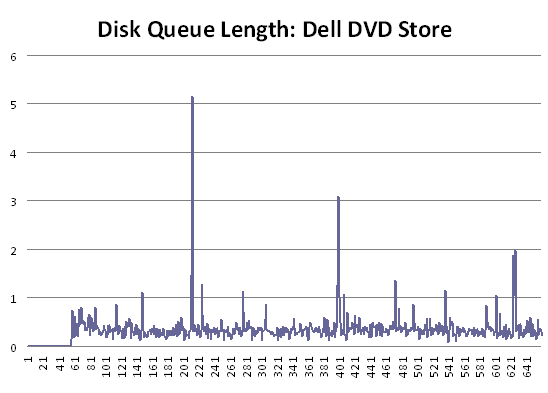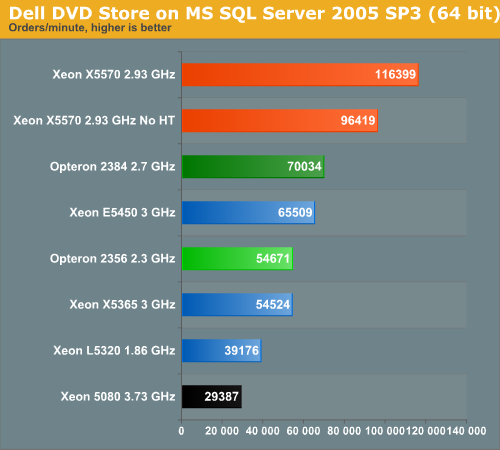The Best Server CPUs part 2: the Intel "Nehalem" Xeon X5570
by Johan De Gelas on March 30, 2009 3:00 PM EST- Posted in
- IT Computing
| OLTP: Dell DVD Store on MS SQL Server 2005 | |
| Operating System | Windows 2008 Enterprise RTM (64-bit) |
| Software | SQL Server 2005 Enterprise x64 SP3 (64-bit) |
| Benchmark software | Dell DVDStore 2 |
| Database Size | 3.5 GB |
| Typical error margin | 2-4% |
DVD Store is a project that the Linux department of Dell developed in 2005 as a test for its internal server laboratory. The DVD Store database schema consists of only eight tables, but it does include stored procedures and transactions. The beauty is that it is available as open source software. This allowed us to turn this into a custom benchmark. With the default settings, the database can only be three sizes: 10MB, 1GB, or 100GB. A 10MB database size is simply too small. A 1GB size does not allow us to scale well, as too much locking contention happens. Those two options are out, but to run DVD Store with a 100GB database as a CPU benchmark, we need to take out a second mortgage on all the houses of our team to pay for the necessary storage racks.
We decided to recompile the test, allowing us to use a 3.5GB database. A 3.5GB database proved to be a good compromise between not needing too much storage speed and making the database scale well to eight cores and beyond. As you can read on our benchmark configuration page, we used a RAID 0 set of six SSDs for the data, and four 15000RPM SAS disks for the logs. We monitored the DQL (Disk Queue Length) to ensure our test was not bottlenecked by the storage subsystem.

Most of the time, our storage subsystem copes well with the transactions (DQL <1), but there are a few brief spikes where the disks are limiting throughput. This means that our fastest CPUs are running at a slightly lower CPU load (Xeon X5570 is at slightly less than 80%) than the slowest CPU (85%). Giving our fastest CPUs an even faster storage system hardly improved performance despite somewhat higher CPU load levels. In reality, it is very unlikely that you will add a few drives because you wish to run your CPU at an 82% instead of 78% CPU load, so we feel this small variation in CPU load is acceptable. This is especially true as the resulting variation in performance is much smaller: we are talking about 2-3% performance variations, well within the error margin of our test.
You can test this OLTP database via a very thin web tier or directly. As the web tier only added noise (it uses the slow ODBC driver!) to our results, we tested directly. All servers were tested in a dual CPU configuration.

The AMD Shanghai has no trouble leaving the older Xeons behind, even at a lower clock speed. The Xeon 5570 does not play in the same class. Thanks to SMT, it is capable of outperforming its older brother by 78% and the competition by 66%. Hyper-Threading gives the Xeon 5570 a 21% performance boost.
One Xeon 5570 server is capable of replacing 3 to 4 older server systems based on the Xeon 50xx series.










44 Comments
View All Comments
gwolfman - Tuesday, March 31, 2009 - link
Why was this article pulled yesterday after it first posted?JohanAnandtech - Tuesday, March 31, 2009 - link
Because the NDA date was noon in the pacific zone and not CET. We were slightly too early...yasbane - Tuesday, March 31, 2009 - link
Hi Johan,Any chance of some more comprehensive Linux benchmarks? Haven't seen any on IT Anandtech for a while.
cheers
JohanAnandtech - Tuesday, March 31, 2009 - link
Yes, we are working on that. Our first Oracle testing is finished on the AMD's platform, but still working on the rest.Mind you, all our articles so far have included Linux benchmarking. All mysql testing for example, Stream, Specjbb and Linpack.
Exar3342 - Monday, March 30, 2009 - link
Thanks for the extremely informative and interesting review Johan. I am definitely looking forward to more server reviews; are the 4-way CPUs out later this year? That will be interesting as well.Exar3342 - Monday, March 30, 2009 - link
Forgot to mention that I was suprised HT has such an impact that it did in some of the benches. It made some huge differences in certain applications, and slightly hindered it in others. Overall, I can see why Intel wanted to bring back SMT for the Nehalem architecture.duploxxx - Monday, March 30, 2009 - link
awesome performance, but would like to see how the intel 5510-20-30 fare against the amd 2378-80-82 after all that is the same price range.It was the same with woodcrest and conroe launch, everybody saw huge performance lead but then only bought the very slow versions.... then the question is what is still the best value performance/price/power.
Istanbul better come faster for amd, how it looks now with decent 45nm power consumption it will be able to bring some battle to high-end 55xx versions.
eryco - Tuesday, April 14, 2009 - link
Very informative article... I would also be interested in seeing how any of the midrange 5520/30 Xeons compare to the 2382/84 Opterons. Especially now that some vendors are giving discounts on the AMD-based servers, the premium for a server with X5550/60/70s is even bigger. It would be interesting to see how the performance scales for the Nehalem Xeons, and how it compares to Shanghai Opterons in the same price range. We're looking to acquire some new servers and we can afford 2P systems with 2384s, but on the Intel side we can only go as far as E5530s. Unfortunately there's no performance data for Xeons in the midrange anywhere online so we can make a comparison.haplo602 - Monday, March 30, 2009 - link
I only skimmed the graphs, but how about some consistency ? some of the graphs feature only dual core opterons, some have a mix of dual and quad core ... pricing chart also features only dual core opterons ...looking just at the graphs, I cannot make any conclusion ...
TA152H - Monday, March 30, 2009 - link
Part of the problem with the 54xx CPUs is not the CPUs themselves, but the FB-DIMMS. Part of the big improvement for the Nehalem in the server world is because Intel sodomized their 54xx platform, for reasons that escape most people, with the FB-DIMMs. But, it's really not mentioned except with regards to power. If the IMC (which is not an AMD innovation by the way, it's been done many times before they did it, even on the x86 by NexGen, a company they later bought) is so important, then surely the FB-DIMMs are. They both are related to the same issue - memory latency.It's not really important though, since that's what you'd get if you bought the Intel 54xx; it's more of an academic complaint. But, I'd like to see the Nehalem tested with dual channel memory, which is a real issue. The reason being, it has lower latency while only using two channels, and for some benchmarks, certainly not all or even the majority, you might see better performance by using two (or maybe it never happens). If you're running a specific application that runs better using dual channel, it would be good to know.
Overall, though, a very good article. The first thing I mention is a nitpick, the second may not even matter if three channel performance is always better.